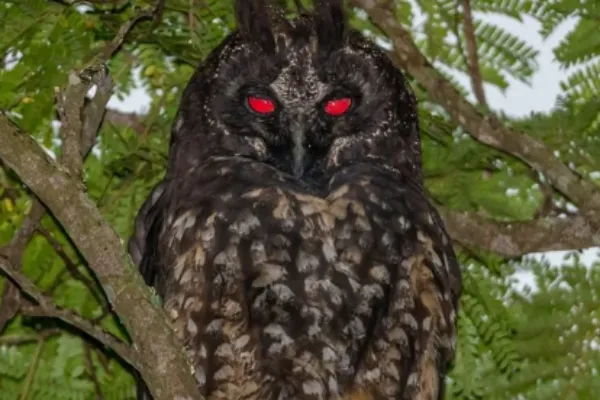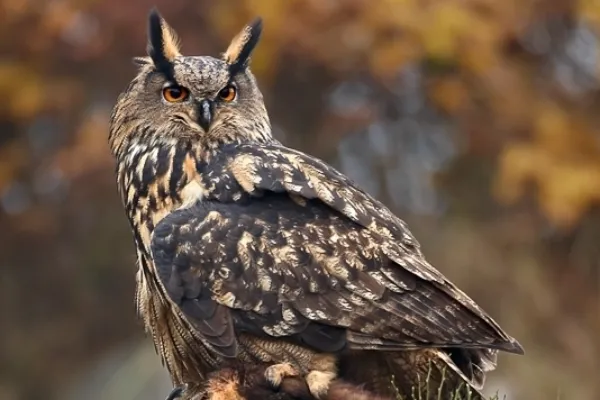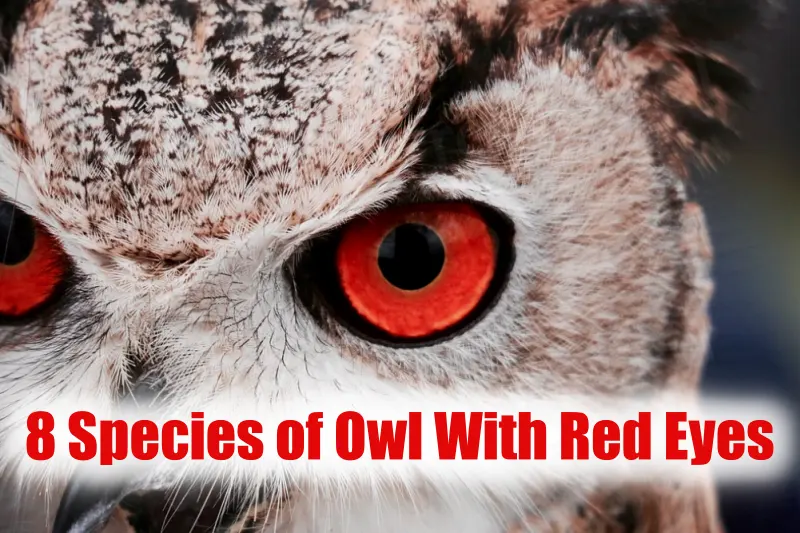We all watched Harry Potter, and we all have a good memory of it. One of the most loyal animals we observed in the whole movie was his owl. This is something we all want to have, but of course, it’s a dream. But have you ever seen an owl with red eyes? Well, here is an owl going viral as a devil owl. This owl has red eyes. If you want to know about it, then let’s go.
8 Owl With Red Eyes
1. Stygian owl

| Scientific name | Asio stygius |
| Size | 38 to 46 cm |
| Identification | Bill is blue-black to blackish |
| Geolocation | Mexico, Central America, Cuba, Hispaniola, and around South America |
The Stygian owl, also known as the devil owl now, has different characteristics that make it noticeable among all the species. This is a medium-sized owl found in Mexico, Central America, Cuba, Hispaniola, and 10 South American countries.
Taking about its body weight, it can be measured at 400 to 675 g and measures 38 to 46 cm in length. Other than that, both sexes have dark plumage. But you can differentiate the male, as they have a blackish face with a pale border and a whitish forehead.
Also, the head has long, dark feathers that project upward like ears. Furthermore, you can also identify this owl with red eyes through its upperparts, which have buff streaks and bars, while the underparts are buff with dark brown or blackish barring and streaks.
In terms of distinguishing characteristics, the eyes are yellow but when they come into contact with light, they turn blood red.
Moreover, the bill is blue-black to blackish, and the feet are dark grayish or brownish pink. The subspecies are substantially alike, with differences in the upper parts’ streaks and size.
Fact about its eyes– this owls eyes glow red when came in contact of light
2. Negros Scops Owls
| Scientific name | Otus nigrorum |
| Size | 15-17.6 cm |
| Identification | V-shaped pattern |
| Geolocation | Philippines |
Otus nigrorum, also known as Negros scops-owl, is a species native to the Philippines. The species is well known for its eye color, which ranges from yellow to red; many also have orange-red eyes.
These owls stand out with their bright red eyes and V-shaped pattern and are native to forests, hiding in tree holes during the day.
Fact about eyes– The owl is popular for its varied eye color range from red, orange-red to yellow.
3. Philippines scops owl
https://in.pinterest.com/pin/69313281765108612/
| Scientific name | Otus megalotis |
| Size | 23 to 28 cm |
| Identification | Dark brown feathers |
| Geolocation | Philippines |
The Philippine scops owl is a mid-sized species with large ears, dark eyes, and dark brown feathers. They have three subspecies, with the smallest having a reddish brown color, no scapular line, and no feathers on its upper feet.
The medium-sized morph lacks a scapular line and feathers on its upper feet but has a grayish-brown color.
The largest, Otus megalotis, also has a gray-brown color but a scapular line and feathers on its upper feet. Other morphological differences between subspecies include the length of the tail, wings, culmen, and tarsus.
Female scops owls tend to be larger in general, but they present some contrast with fluffy rufous feathers.
Once they reach sub-adult age, they turn black and greyish-white until they reach adulthood and turn brownish. The owls’ morphology is not significantly different between male and female species.
Fact about eyes– The owl has dark red color of eyes.
4. Mentawai scops owl
https://in.pinterest.com/pin/125115695877297448/
| Scientific name | Otus mentawi |
| Size | Approx. 20 cm |
| Identification | Dark brown plumage |
| Geolocation | Mentawai, west Sumatra, Indonesia |
This dark cinnamon-brown owl is the only resident scops owl in its limited range, inhabiting various wooded habitats.
It gives a barking hoot with abrupt endings and quiet, low-rattling croaks.
Its combination of dark eyes and uniformly dark brown plumage distinguishes it from migrant or vagrant scops-owls on the Mentawai Islands. Its eyes glow red in light contact.
Fact about eyes– The owl has dark eyes ranges from brown to red.
5. Long-eared owl
| Scientific name | Asio otus |
| Size | 31 to 40 cm |
| Identification | Slender with long ear tufts |
| Geolocation | Northwestern Africa, Iberian Peninsula, British Isles, Sakhalin, Japan and northern China |
The long-eared owl, also known as the northern long-eared owl or lesser-horned owl, is a medium-sized species of owl with an extensive breeding range across the Northern Hemisphere.
It measures between 31 and 40 cm in total length and is slender with long “ear” tufts. North American birds are dark and coarsely marked, while Eurasian populations are paler and have reddish eyes. The species of owl found in Eurasian region has red eyes.
The long-eared owl is nocturnal and rarely seen foraging at dusk and dawn. They are found in areas with dense cover for roosting and open spaces for hunting.
They are generally uncommon to rare and seldom seen, but they can gather in communal winter roosts with dozens of individuals. Their typical vocalization is a single low “woop” repeated every few seconds.
Fact about eyes– This owl species has a unique feature the owl found in North America has yellow eyes while the owl found in Eurasia has red eyes.
6. Eurasian eagle-owl

| Scientific name | Bubo bubo |
| Size | 56 to 75 cm |
| Identification | Ear tufts with mottled upper parts |
| Geolocation | Europe and Eurasia |
Next on the list is the Eurasian eagle owl, also known as the Uhu or eagle owl in Europe, a large species of owl found in Eurasia. Females can reach a wingspan of 188 cm and can grow up to 75 cm.
The bird has distinctive ear tufts with mottled upperparts and tawny underparts. The total length of the species can range from 56 to 75 cm.
The iris of some European birds is reddish, blood-orange, while in arid habitats, it can range into orange-yellow. Most closely related species have yellowish irises, except for the Indian eagle-owl.
Fact about eyes– The owl has red, blood orange, orange-yellow eye color.
7. Japanese scops owl
| Scientific name | Otus semitorques |
| Size | 16.5 to 30 cm |
| Identification | The pale grey-brown facial disc |
| Geolocation | Japan, China, Korea, and Russia |
Next, the Japanese scops owl is a small owl species in the Strigidae family, belonging to the genus Otus. It is native to Japan, China, Korea, and Russia. Standing 16.5–30 cm tall with a wingspan of 60–66 cm, they weigh 130–200 grams and have gray and brown plumage.
Their wings are long and pointed, and they have prominent ear tufts. The species has a pale gray-brown facial disc, intense red eyes, green feet with feathered toes, and a green bill.
They are often confused with the Collard scops owl and the Northern white-faced owl, both smaller and whiter but similar in size. They can reach flight speeds of 80 kph.
Fact about eyes– The owl has an intense red eyes.
8. Southern white-faced owl

| Scientific name | Ptilopsis granti |
| Size | 22-28 cm |
| Identification | Upper parts are dark grey |
| Geolocation | southeastern Gabon, southern Uganda, southwestern Kenya, Namibia, northern and central South Africa, Lesotho, Swaziland, and Mozambique |
The Southern White-faced Owl is a small owl with a distinctive white face, large orange-red eyes, long ear-tufts, and dark-streaked pale grayish plumage. Its facial disc is almost pure white with a broad black rim, and its eyes are orange-red to red.
The upper parts are dark gray, with well-pronounced black shaft streaks and fine vermiculations. The outer webs of the scapulars are white, edged in black, and form a white line across the shoulder.
Underparts are paler gray with fine blackish shaft streaks and fine dark vermiculations.
Tarsi are feathered pale gray to the basal half of the toes, and the toes are dusky greyish-brown with blackish-horn claws. The Southern White-faced Owl is a nocturnal bird with habits not well studied, possibly similar to the Northern White-faced Owl.
Fact about eyes– The owl has red to orange-red eye color.
Conclusion:
So here we look at some of the species of owl with red eyes; you might find them amazing and interested in learning more about them. These owls have distinct features, and their features make them remarkable among others. If you are looking to learn more about them, then keep looking for them on HowItSee.
Reference:
- Wikipedia
- https://ebird.org/species/loeowl#:~:text=Medium%2Dsized%2C%20rather%20slender%20owl,face%2C%20and%20have%20reddish%20eyes
- https://en.m.wikipedia.org/wiki/Eurasian_eagle-owl#:~:text=In%20some%20European%20birds%2C%20the,the%20Indian%20eagle%2Dowl
- https://www.owlpages.com/owls/species.php?s=1170#:~:text=The%20Southern%20White%2Dfaced%20Owl,dark%2Dstreaked%20pale%20greyish%20plumage
Also Read:

As a content writer, I like to write about different niches. I have a curiosity about nature and animals. And like to learn about them. Through my writing, I like to share my experience and knowledge with you. I hope you are enjoying it too.

